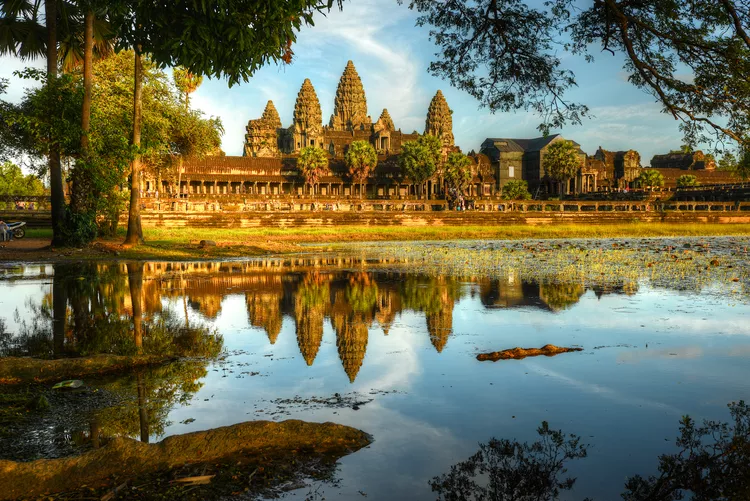1. Overview
This guide provides essential travel information for visiting Cambodia, including visa requirements, health precautions, customs regulations, currency, safety tips, and clothing recommendations.
Visas, Currency, Holidays, and Weather
There’s a charm unique to Cambodia that can’t be felt in other places of the world. Still considered one of the poorest nations, this country is rich in agricultural heritage and ancient world traditions. Planning your trip carefully will send you on your way prepared. Secure necessary visas and immunizations and gain a grasp of how to navigate the country before you leave.
Securing Your Visa
Visitors to Cambodia must present a valid passport with an expiration of at least six months after their visit, along with a Cambodian visa. To obtain a visa, contact the Cambodian embassy in the U.S. Mail in a completed visa application form, a recent 2-inch by 2-inch photograph, and 35 U.S. dollars. Alternatively, you can apply for a Cambodian e-visa online by completing the online application form and paying with your credit card. Once you receive your visa via email, print it out and carry it with you to Cambodia. The visa remains valid for 30 days from the date of issue. For those anticipating an extended stay, a multiple-entry visa with a validity of up to three years can be obtained.
If you encounter a mishap or wish to extend your stay, apply for a visa extension through either a travel agency or directly at the immigration office in Cambodia. A 30-day extension costs 40 U.S. dollars. Alternatively, if you’re near a border crossing, you may perform a visa run to a neighboring country and then return. Overstaying tourists will be fined six dollars per day for expired visas.
Immunizations and Health Concerns
Take all necessary health precautions before flying to Cambodia. Schedule a checkup, secure prescription medicine, and receive immunizations. Quality hospital facilities are rare, and pharmacies are limited in this country. Any major health issues will need to be addressed outside of Cambodia, with the closest quality medical care available in Bangkok.
While specific immunizations are not required for entry, a malaria vaccine is highly recommended, especially since malaria-carrying mosquitoes are prevalent in the countryside during the rainy season. Therefore, additionally packing bug repellent and a bug net for nighttime use is advisable. Long-sleeve shirts and long pants are recommended for evening wear.
Other diseases such as cholera and typhoid fever also exist in Cambodia; thus, obtaining vaccinations for these diseases, along with updating your tetanus, hepatitis, and polio shots, is prudent.
Customs Regulations
Visitors 18 years and older are permitted to bring 200 cigarettes (or an equivalent quantity of tobacco), one opened bottle of liquor, and perfume for personal use into Cambodia. All currency must be declared upon arrival, and visitors are prohibited from carrying antiques or Buddhist reliquaries out of the country. However, purchases from souvenir stands, such as Buddhist statues and trinkets, can be taken home.

Money in Cambodia
Cambodia’s official currency is the riel, which is available in denominations of 100, 200, 500, 1000, 2000, 5000, 10000, 50000, and 100000 notes. Moreover, U.S. dollars are widely accepted in major towns and cities. It is advisable to use traveler’s checks and cash since credit cards are accepted only sporadically.
Traveler’s checks can be exchanged at any bank, with an additional fee of about 2 to 4 percent to convert U.S. checks into Cambodian dollars. Thus, carrying dollars in small denominations and exchanging them incrementally will be beneficial, as changing riels back to dollars is nearly impossible. Although ATMs occasionally dispense U.S. dollars, relying on cash remains essential.
Safety in Cambodia
Street crime poses risks in Phnom Penh, especially at night and even in popular tourist areas. Bag-snatching is a concern in urban settings, usually carried out by young men on motorcycles. To mitigate this risk, keep your belongings minimal and secure wallets and purses beneath your clothing.
Cambodia continues to grapple with being one of the most heavily land-mined countries globally; however, this shouldn’t concern you unless you venture near the Vietnam border. Traveling with a local guide and adhering to marked paths will ensure your safety.
Avoid supporting orphanage tourism, where some tour agencies in Siem Reap profit by bringing tourists to orphanages for apsara dance performances or English teaching. This industry exploits disparities and tends to do more harm than good.
What to Wear
Durable walking shoes and waterproof rain gear are essential for traveling within Cambodia. While the rainy season typically occurs between May and October, shower patterns can be unpredictable. Therefore, light cotton or breathable fabrics are ideal in this tropical climate. Moreover, both men and women are advised to wear modest clothing, especially when visiting religious sites like the Angkor temples.





